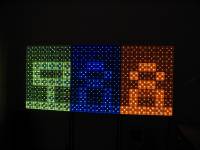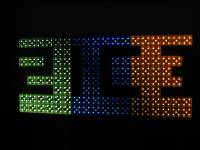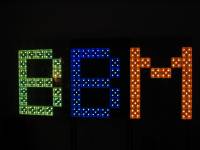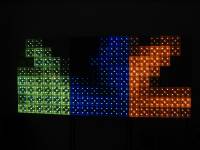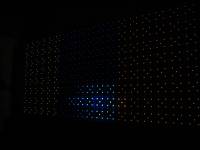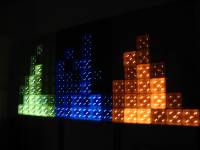|
BlinkenArea.TroiaPrototypEnglish
144 pixels ought to be enough for anybody |
|
|
powered by:
![[Powered by Eventphone]](/pub/Main/BlinkenAreaLinkMenu/eventphone-logo.gif)
|
|
It was the goal to develope a technology for the Project Troia, which makes possible to equip a room with 20.000 pixels and control them in 128 greyscales. To test the feasibility of our project, we built a prototype with 144 pixels together with the BBMs. We chose 144 pixels to use the already existing Blinkenlights movies and games, as well as parts of the running control-software from previous projects. The system is modular extendable, which means, if it is working with 144 pixels, it can be extended as big as you like. First we had to think about how a pixel should look like. Because we got a lot of SMD LEDs (LW T673) quite cheap, we were certain about the illuminant. It had only to be proofed, how many LEDS have to be used for one pixel. Therefore we etched and equiped several boards. Pictures of the test-boards, as well as layouts can be found at the Troia-testpixel site. After extensive tests we decided for a board with 5 LEDs and big cooling surfaces, which is sticked into the deep-drawed pixel-box.
The activation of each pixel, which consists always of a series connection with 5 very bright, white LEDs, occurs through pulse width modulation (PWM). That means, the greyscales are simulated by very fast on-off-switching. The human eye is too sluggish to discern the flickering (around 100 Hz). Because a task like this can not take on by one PC for 20.000 pixels, the generation of the PWM-signals are made by the Troia pixel modules. Such a module controls up to 32 pixels. But for the prototype only 24 pixels were hooked up to each of the 6 modules. The data, which have to be shown, are seriell transfered via a 10 mA Current Loop (galvanically isolated by an opto-coupler) with a rate of 38400 bps. To make possible connecting enough pixel modules to a PC, we developed the Troia distributing modules. These are able to put out serial data for up to 32 pixel modules. So each Troia distributing module controls up to 1024 pixels. Via USB 2.0 then 20 (or more) Troia distributing modules can be connected to the PC. On this PC is running Linux with a special kernel-module, which is editing the data for the modules and sending them. Here some pictures of the finished prototype:
The area of pixels of this prototype is 1,20 x 2,70 meter. To make it easier to transport, the prototype was built in 3 pieces with 48 pixels each. These 3 components can be put on a welded steel-rack, which was made by the BBMs for this purpose.
-- KatharinaMueller (translation) - 04 Jun 2004 -- StefanSchuermans - 12 May 2004 -- STephanKambor - 03 Sep 2004 |
|
|
![[SMD LED]](https://oldwiki.blinkenarea.org/pub/Blinkenarea/TroiaPrototyp/smd-led.jpg)
![[Troia Prototyp - alle an]](/pub/Blinkenarea/TroiaPrototyp/troia.prototyp-alle.an-thumb.jpg)
![[Troia Prototyp - BBM]](/pub/Blinkenarea/TroiaPrototyp/troia.prototyp-bbm-thumb.jpg)
![[Troia Prototyp - Scheibe]](/pub/Blinkenarea/TroiaPrototyp/troia.prototyp-scheibe-thumb.jpg)
![[Troia Prototyp - BB=]](/pub/Blinkenarea/TroiaPrototyp/troia.prototyp-bbo-thumb.jpg)
![[Troia Prototyp - Graustufen]](/pub/Blinkenarea/TroiaPrototyp/troia.prototyp-graustufen-thumb.jpg)
![[Troia Prototyp - gruen]](/pub/Blinkenarea/TroiaPrototyp/troia.prototyp-gruen-thumb.jpg)
![[Troia Prototyp - Pong]](/pub/Blinkenarea/TroiaPrototyp/troia.prototyp-pong-thumb.jpg)
![[Troia Prototyp - Tux]](/pub/Blinkenarea/TroiaPrototyp/troia.prototyp-tux-thumb.jpg)
![[Troia Prototyp - XXO]](/pub/Blinkenarea/TroiaPrototyp/troia.prototyp-xxo-thumb.jpg)
